In this post, we will explore factions, why they are one of the most underused yet powerful storytelling tools in Dungeons & Dragons, how I have expanded on them with a new mechanic in Medieval 5e, and how they play a vital role in Ghosts of Saltmarsh.
Why Factions Matter
Factions are often mentioned in Dungeons & Dragons sourcebooks but rarely developed into true campaign tools.
Ghosts of Saltmarsh references them and even provides a few roll tables for faction-related quests, yet the Dungeon Master’s Guide and Player’s Handbook offer little practical guidance on how to make factions come alive at the table.
That’s a missed opportunity.
While the 2024 Dungeon Master’s Guide does not include guidance on factions, it does introduces a new social framework with three simple attitudes; Friendly, Indifferent, and Hostile. Each determining whether a character rolls with advantage, normal, or disadvantage when trying to influence another creature. It’s simple, efficient, and easy to teach.
But it is also highly transparent: players immediately know whether they’re dealing with an ally or an enemy. While a monster or bandit trying to rob you is clearly an enemy, it is less nuanced dealing with NPCs.
This simplicity removes the gray areas where politics, manipulation, and uncertainty thrive.
In a world like Saltmarsh, where loyalties shift and motives hide beneath polite words, that transparency can drain tension from social play.
True factional drama depends on secrecy, reputation, and consequence that emerge not from open modifiers, but from diegetic play, tone, and reaction.
Factions shape nearly every part of the game world; they influence how adventures begin, who aids or hinders the party, what rewards are offered, and how the characters are perceived by others.
They give texture to the setting, grounding it in politics, belief, and shared history.
Most importantly, they create verisimilitude (the sense that the world is real).
What Is a Faction?
Simply put, a faction is a group of people who share a common goal or interest.
They can be a small frightened village banding together to slay a beast threatening their livestock or a secretive hidden cult, a merchant guild, or knightly order.
The Narrative Power of Factions
Because factions are built on shared purpose, they naturally create story hooks and character motivations:
- Aid & Shelter – A faction may offer safe lodging, food, or sanctuary.
- Training & Resources – Access to mentors, craftsmen, or rare equipment.
- Quests & Missions – Tasks that advance both the faction’s agenda and the party’s goals.
- Conflict & Intrigue – Rival factions spark politics, betrayal, and moral choices.
- Rewards & Recognition – Gold, favors, titles, or influence.
Help a village destroy the monster killing their livestock and you will always have a safe bed and a grateful blacksmith ready to mend your blade.
Guard a merchant caravan and you might gain new contacts, information, and coin from the Merchant Guild.
But cross the wrong group, steal from an order, betray a guild and those same allies may become relentless enemies.
Characters can gain favor with multiple factions, but that comes with risk. Holding the trust of rival groups invites suspicion, and exposure can quickly turn allies into adversaries.
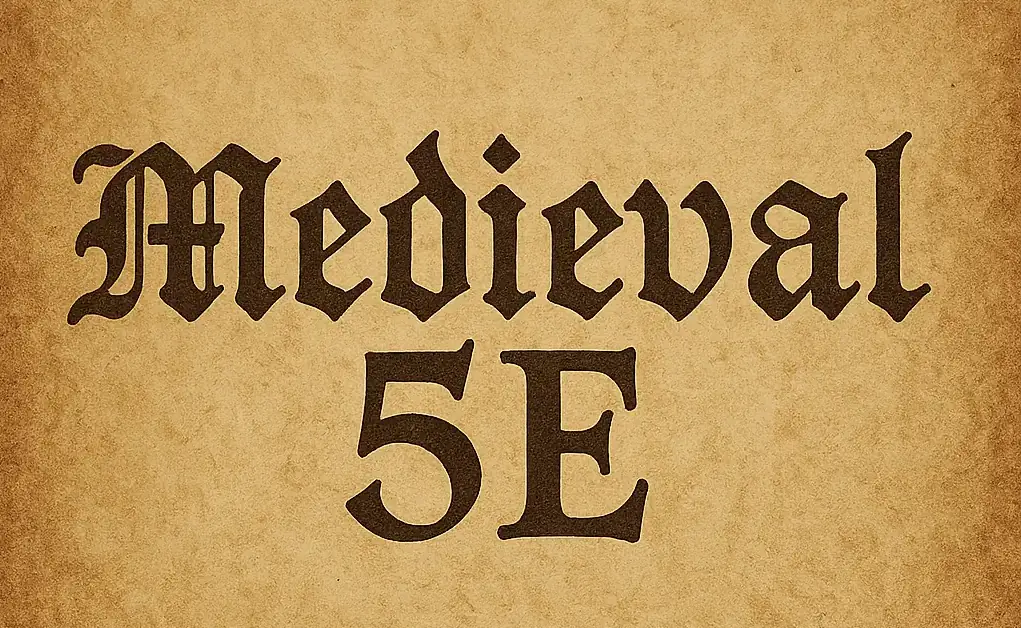
Factions as a Mechanic in Medieval 5e
Factions are powerful narrative tools. In my upcoming TTRPG, Medieval 5e, I have introduces a simple, elegant framework to help Game Masters manage alliances, rivalries, and social attitudes through consistent, diegetic play.
Faction Relations & Consequences
Factions and the individuals within them respond to the party based on reputation and history. A faction’s attitude shapes tone, aid, resistance, and consequence.
Faction Relation Table
| Relation | Engagement & Effects |
|---|---|
| Enemy DC 20+ |
Openly hostile. May issue bounties, sabotage plans, or attack on sight. Only leverage, fear, or necessity can shift their stance. |
| Unfriendly DC 15–20 |
Distrustful or resentful. Works against the party’s interests through rumor, politics, or obstruction. Refuses aid unless coerced or bribed. |
| Neutral DC 10–15 |
Cautious or uncertain. Will listen, but requires proof, reason, or shared interest before committing. Their attitude can shift easily with action. |
| Friendly DC 5–10 |
Warm and receptive. Offers small favors, introductions, or information. Welcomes the party and speaks well of them among peers. |
| Ally DC 0–5 |
Deep loyalty and trust. Will shelter the party, defend their reputation, and risk personal safety or resources on their behalf. No roll needed unless the request is extreme. |
Examples in Play
Friendly: The party slays a beast that terrorized a village. Grateful villagers provide rooms, food, and lasting goodwill.
Ally: The heroes save a noble’s life at great personal risk. The noble’s house adopts them as kin, offering sanctuary and political protection.
Enemy: The party kills a guild leader’s brother. The guild retaliates with contracts on their lives and a smear campaign across the coast.
The Spectrum of Extremes
Reaching the extremes (Enemy or Ally) is rare and hard-earned.
- Enemy (DC 20 +) The faction seeks to harm or destroy the party. Redemption requires extraordinary sacrifice or diplomacy.
- Ally (DC 0 – 5) The faction treats the party as family. Their loyalty is proven through shared peril and is difficult to lose.
Context is everything.
Even trusted allies may hesitate to risk their family or fortune, and sworn enemies may still parley if survival or profit demands it.
When an ask crosses moral or existential limits, no roll may suffice, the NPC simply refuses. The world stays grounded in consequence and human limitation.
Individual vs. Faction Relations
A faction’s stance sets the baseline, but individuals may differ.
A commander might personally admire the party even if their order despises them, while a loyal subordinate might refuse aid if it means betraying their oath.
Always judge personal relationship alongside faction attitude.
Trust is earned through deeds, not declared in words.
Faction & NPC Attitude Ladder
Attitudes define how factions and individuals feel toward the party.
They establish a baseline Difficulty Class (DC) for social interactions, which can shift up or down through diegetic play, tone, leverage, or circumstance.
This table provides cues and reactions to help the DM describe behavior without revealing numbers.
| Perceived Attitude | Relation | DC Range | Behavior & Cues | Typical Effects |
|---|---|---|---|---|
| Open Hostility | Enemy | 20+ | Aggressive, confrontational, or openly threatening. Refuses parley; seeks conflict or sabotage. | Direct opposition. Only fear, leverage, or shared survival may alter stance. |
| Suspicious or Cold | Unfriendly | 15–20 | Short tone, guarded posture, visible distrust. Courtesy masks contempt. | Resists persuasion; demands proof, payment, or authority before cooperating. |
| Even or Reserved | Neutral | 10–15 | Measured, professional, or cautious. Observes before committing. | Balanced position; open to influence through action or tone. Can shift easily with context. |
| Warm or Welcoming | Friendly | 5–10 | Relaxed posture, smiles, approachable tone. | Offers introductions, minor favors, or useful information. Genuinely supportive. |
| Loyal or Devoted | Ally | 0–5 | Protective stance, proactive aid, speaks well of the party in all circles. | Risks reputation or safety to defend or assist the party. No roll needed unless the ask is extreme. |
How to Run Social Encounters
Secret DCs & Perceived Attitude
Always keep DCs secret.
Instead, describe the NPC’s perceived attitude before the roll, giving players emotional context without numbers.
“The guard seems suspicious of you.”
This frames the scene emotionally rather than mathematically.
Diegetic Play
Players should not say “I roll Persuasion.”
They describe actions, tone, and dialogue in character.
The GM may request clarity before deciding which skill applies.
“I lower my voice. ‘Sergeant, Fireborn has granted us permission, let us through!’”
Setting the DC
Set the DC in secret, using the NPC’s relation (see ladder) and the fictional context.
After the player’s declaration, choose which ability or skill fits the action.
- Baseline (Unfriendly): DC 15-20
- Good roleplay or leverage: Lower to 10-15
- Arrogance or insult: Raise beyond 20
Example: The guard begins Unfriendly (15-20). The party mentions Fireborn, his commanding officer, and thus lowers the DC to 12.
Rolling the Check
Once the DC is set, tell the player what to roll, not the DC (remains secret).
“Make a Persuasion check.”
You may hint at shifting tone (“He seems to soften, considering what you said.”) but never reveal the number.
Narrating the Outcome
Describe results through fiction, not math.
- Success: “He exhales and lowers his spear. ‘My apologies.’”
- Failure: “He stiffens. 'I am not authorized, you will need to get a letter from Fireborn or find a proper escort."
Guiding Principles
- Context is everything. Tone, history, leverage, and timing define difficulty.
- Perceived attitude helps players understand the probability of success.
- Declare action first; roll only if uncertainty remains.
- Keep it secret, keep it diegetic. Let fiction, not numbers, drive the moment.
Manipulation & False Attitudes
Not every friendly face is sincere.
Some NPCs and factions use false attitudes to deceive or mislead. They may seem Friendly (DC 5 – 10) while their true intent is Unfriendly (DC 15-20) or even an Enemy (DC 20+)
Manipulation is not a single check; it is obfuscation through behavior, lies, charm, and controlled emotion.
How Manipulation Appears
An NPC acts afraid, overly helpful, or too easily persuaded, sharing privileged information or conceding quickly. In truth, they’re steering the party toward danger or delay.
A trembling dockhand reveals smuggler hideouts.
In reality, he is an agent for the Scarlet Brotherhood, sending the party into an ambush.
Insight & Deception
Insight is not a lie detector.
It reveals tone, tension, and inconsistency, not truth.
Describe perception, not verdict.
| Result | Narrative Example |
|---|---|
| Fail | “He seems shaken and genuine.” |
| Partial Success | “Parts of his story sound rehearsed, but fear makes it believable.” |
| Success | “His eyes flick toward the door as he talks.” |
Setting the DC for Deception
When deception is in play, treat the NPC’s true attitude as Unfriendly, giving Insight DC 15+. Keep these DCs secret, revealing them exposes the lie.
Manipulation thrives on contrast:
- Perceived Attitude: Low DCs for Persuasion or Intimidation (they seem Friendly).
- True Intent: High DCs for Insight (they are hiding something).
This balance keeps interaction immersive, the world can lie, but the dice remain honest.
Design Note
Manipulation works on dual truth:
- The surface attitude shapes what the NPC shows.
- The hidden intent drives what they want.
Play both sincerely, the deceit should feel real, not mechanical.
Gaining & Losing Favor
Gaining Favor: Complete quests, defend allies, uphold values, or invest in the faction’s goals.
Losing Favor: Act against their interests, aid their rivals, or betray their trust.
Final Thought
The Medieval 5e Faction System is lightweight, intuitive, and deeply narrative.
It rewards meaningful choices and makes loyalty, politics, and reputation matter.
Use it seamlessly with Ghosts of Saltmarsh or any campaign where intrigue and consequence drive the story.
Factions in Ghosts of Saltmarsh
Ghosts of Saltmarsh introduces three central factions that define the town’s politics and identity. Their motives and rivalries shape every council meeting, tavern debate, and back-alley whisper. For Game Masters, they provide a perfect foundation for faction-based play within the framework of Medieval 5e’s faction system.
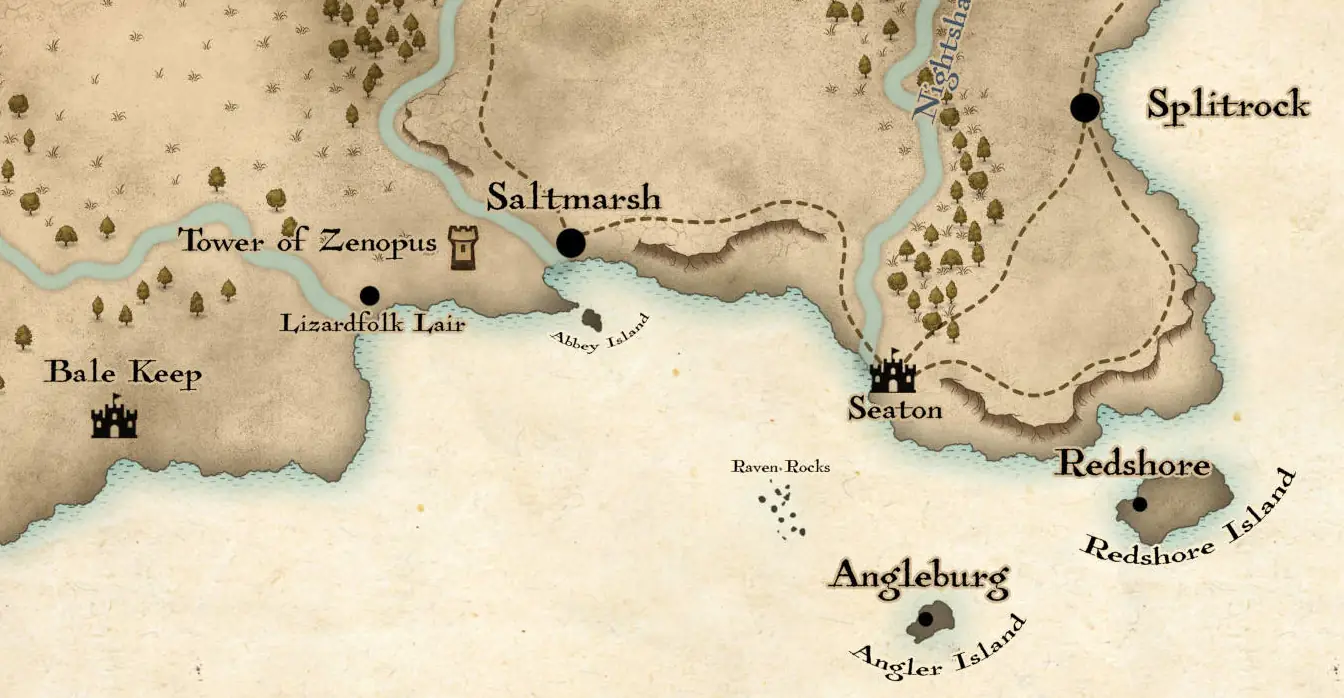
The Traditionalists
The Traditionalists are townsfolk who wish Saltmarsh to remain the quiet fishing village it has always been. They value independence, tradition, and the sea. They prefer to stay out of Keoland’s politics, viewing the kingdom’s military ambitions with suspicion.
Many oppose the new dwarven mining operation on the coast, fearing pollution, the death of the fish, or an influx of merchants and mercenaries who might erode their way of life. Smugglers, aligned with Traditionalist, seeing the presence of the royal garrison as a threat to their livelihood.
- Typical Allies: Old fishing families, dockworkers, independent merchants.
- Typical DC Range: 10–15 depending on context (Neutral). They are less trusting of outsiders.
- Faction Goals: Preserve autonomy, resist taxation, and limit royal interference.
The Loyalists
The Loyalists welcome change and progress. They support Keoland’s presence in Saltmarsh and the royal garrison stationed there. To them, the dwarven mines symbolize opportunity; trade, jobs, and wealth for all. They see the garrison as essential to defend against monsters, raiders, and pirates along the coast.
Loyalists are pragmatic, often more educated, and forward-looking. They want Saltmarsh to grow into a prosperous port like Seaton, believing modernization is the key to survival.
- Typical Allies: Dwarves, soldiers, royal officers, and ambitious families.
- Typical DC Range: 10–15 depending on tone (Neutral). More welcoming to outsiders.
- Faction Goals: Expand trade, strengthen Keoland’s rule, and secure the coast.
Party Introduction
When the adventurers first arrive in Saltmarsh, they are complete outsiders.
Their initial standing is Neutral (DC 10-15) with both the Traditionalists and the Loyalists.
- The Traditionalists begin slightly more guarded, lean towards DC 15, as they are slow to trust strangers and wary of change.
- The Loyalists, by contrast, are somewhat more open, lean towards DC 10, seeing newcomers as potential allies, laborers, or traders who might help Saltmarsh grow.
Run early interactions on an individual basis.
A friendly dockhand might greet the party with curiosity and warmth, while a suspicious guard eyes them with distrust. Each conversation, favor, or misstep helps define how the factions perceive them.
Over time, consistent actions and attitudes shape the party’s political alignment, whether they stand with the Traditionalist or the Loyalist.
Encourage players to speak their opinions and form relationships openly; every statement, alliance, or insult can shift loyalties.
Saltmarsh’s politics are intimate, emotional, and reactive, where reputation and consequence weave directly into play.
Politics in Motion
The Saltmarsh Town Council is split between these two factions.
Both claim to serve the town’s welfare, but disagree profoundly on what that means.
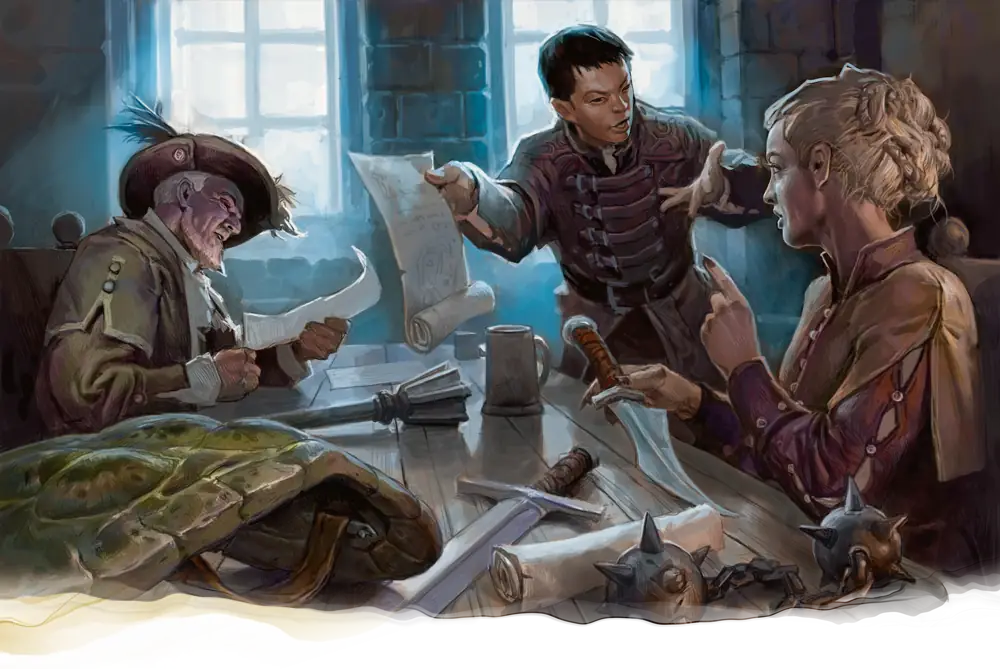
For players, this political divide becomes a social compass. Early on, the party will start Neutral (DC 10–15) with both sides. The locals may be polite but reserved toward outsiders. Over time, their choices, who they aid, what they say, and which jobs they take, will naturally shift their favor.
Example:
Capturing a smuggler ship earns praise from the Loyalists and public approval from the Traditionalists. Yet beneath the surface, Councilman Gellan Primewater, a Traditionalist and secretly the leader of the smugglers, now views the party as a threat. The Smugglers may form a hidden faction Enemy (DC 20+).
This kind of political layering makes Saltmarsh feel alive. The party’s reputation spreads through gossip, tavern talk, and the whispers of dockhands.
Every good deed earns a rival.
The People of Saltmarsh
Saltmarsh is small, fewer than a thousand and everyone has an opinion.
The town’s tension lies between heritage and progress, fishers and miners, locals and outsiders.
- Traditionalists: Fishermen, dockhands, and old families tied to the sea.
- Loyalists: Dwarves, soldiers, merchants, and those hungry for prosperity.
Even those who dislike Keoland’s reach still appreciate the garrison’s protection from the horrors of the Hool Marshes. Yet that same presence breeds unease, talk of war with the Hold of Sea Princes (pirates) drifts through every tavern.
As GM, telegraph these attitudes through rumor, tone, and environment. Let players hear snippets of conversation, see divided crowds, and feel that their words matter.
Saltmarsh is a small town and small towns talk.
Helping or offending the wrong person can shift an entire faction’s stance.
The Scarlet Brotherhood
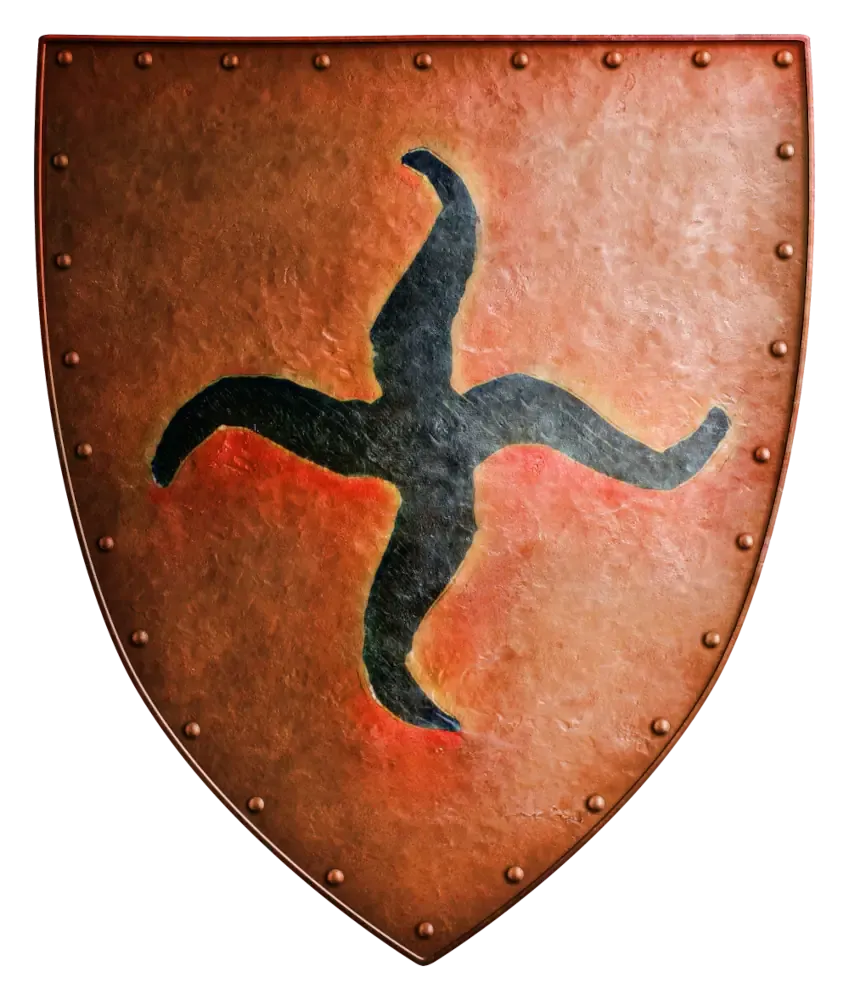
Lurking in the shadows is the Scarlet Brotherhood, a secretive, manipulative order dedicated to destabilizing Keoland and sowing chaos along the coast. Their influence spreads, corrupting both Traditionalists and Loyalists from within.
In Greyhawk canon, the Scarlet Brotherhood is one of the primary catalysts of the Greyhawk Wars, as a key manipulator whose actions ignite and prolong the conflict.
In Saltmarsh, Skerrin Wavechaser, the butler to young Councilman Anders Solmor, is a Brotherhood agent. Though Anders is a Traditionalist, Skerrin’s subtle manipulation causes him to occasionally side with the Loyalists, making him a political wildcard and creating chaos and distrust.
The Brotherhood may even manipulate the adventurers, offering false aid, posing as allies, or masquerading as members of the opposing factions to provoke unrest.
Their goal is not victory but chaos.
The Brotherhood thrives on divided loyalties, misinformation, and fear.
For this reason, DMs should track the Scarlet Brotherhood as a secret faction, unseen by the players.
Their perceived attitude may seem Friendly (5–10), but their true intent is Enemy (20+). A perfect example of manipulation and false attitudes.
Running Factions in Saltmarsh
Use faction attitudes dynamically.
- Traditionalists and Loyalists should feel like two halves of the same community, both right in their own way.
- The Scarlet Brotherhood serves as the hidden hand, twisting politics behind the scenes.
- Every major NPC, guild, or group can be given a Faction Tag and Attitude State (Friendly, Neutral, etc.) to guide interactions and social DCs.
By combining Medieval 5e’s Faction Ladder with Ghosts of Saltmarsh’s political landscape, you create a living world where reputation matters, secrets fester, and the consequences of every choice ripple through the town.
Saltmarsh becomes not just a backdrop, by a complex political landscape in the campaign that shapes player decisions and outcomes.
Faction Quick Reference: Saltmarsh
| Faction | Goals | Allies | Attitude / DC | Typical Reactions |
|---|---|---|---|---|
| Traditionalists | Keep Saltmarsh small and independent; resist Keoland control; oppose dwarven mines. | Old fishing families, dockworkers, local traders; some smugglers. | Neutral (10–15) | Polite but guarded; favor sea-born heroes; dislike taxes/mandates. |
| Loyalists | Modernize under Keoland; back the garrison; expand trade; leverage the mines. | Dwarves, soldiers, officials, merchants. | Neutral (10–15) | Respect order; hire proven adventurers; distrust smugglers. |
| Scarlet Brotherhood (hidden) |
Destabilize Keoland via secrecy, division, infiltration. | Agents, spies, corrupted officials. | Perceived: Friendly (5–10) True: Enemy (20+) |
Feign aid/fear; seed misinformation; pit factions against each other. |
| Smugglers (hidden) |
Protect illicit trade; evade royal interference; leverage local ties. | Dockhands, corrupt guards, pirates, gray-market merchants. | Perceived: Neutral (10–15) True: Unfriendly (15-20) |
Friendly in taverns; retaliate if threatened; may hire or betray. |
Using This Table
- The Traditionalists and Loyalists are public factions, their motives and attitudes are visible to the players. Traditionalists begin wary of outsiders, though patience and shared values can earn their trust.
- The Scarlet Brotherhood and Smugglers are hidden factions. Their influence operates quietly; their true loyalties are uncovered only through discovery, consequence, or betrayal. They routinely will try to manipulate the party.
- Adjust DCs according to tone, leverage, and history, using the Faction & NPC Attitude Ladder from earlier in this post.
- A faction’s baseline attitude evolves as the party engages with Saltmarsh, their words, deeds, and choices gradually reshaping how the town sees them.
Example in Play
The party exposes a ring of smugglers.
The Loyalists cheer them as heroes (Friendly, DC 10).
The Traditionalists publicly thank them (Neutral, DC 15) but quietly (secretly) resent the loss of income (Unfriendly, DC 18).
Meanwhile, the Scarlet Brotherhood takes note and begins planning to use the disruption to its advantage.
Conclusion: Bringing Factions to Life at the Table
Factions are more than background flavor, they are the social engine of the campaign world. They give context to player choices, turning victories into alliances, mistakes into rivalries, and every quest into part of a living political web.
In Ghosts of Saltmarsh, these shifting loyalties transform simple missions into meaningful stories. When players realize that helping one group may alienate another or that their actions have drawn the attention of unseen powers like the Scarlet Brotherhood, the world suddenly feels alive, political, and unpredictable.
Practical Tips for DMs
1. Track Favor on a Simple Scale
Keep a running note of each faction’s current attitude toward the party (Ally, Friendly, Neutral, Unfriendly, Enemy). Update it whenever the party completes a quest, offends a leader, or changes public opinion.
2. Reflect Favor in Play
Show relationships through small, observable details.
- A Friendly Loyalist faction might grant a private audience with Fireborn, share rumors, or offer paid work.
- If Unfriendly with the Traditionalists, shopkeepers might overcharge, gossip spreads, or rooms are not available at Traditionalist friendly inns.
Small, consistent signals make the world feel reactive and real.
3. Introduce Factions Gradually
Players do not need to meet every faction at once. Begin with visible, public groups like the Traditionalists and Loyalists. Reveal hidden factions over time, like the Smugglers or the Scarlet Brotherhood, through discovery, rumor, and consequence. Let factions emerge naturally through play, not exposition.
4. Let Factions Interfere with Each Other
Use rival agendas to create tension and moral choices. One faction spreads rumors about another, sabotages a shipment, or offers competing rewards for the same goal. This creates a dynamic political ecosystem where player actions have ripple effects.
5. Use Secrets to Build Suspense
Keep some loyalties uncertain. Do not share every NPC as a Loyalist or Traditionalist, let players infer it through words, tone, and actions. The Scarlet Brotherhood thrives on ambiguity; let their influence be felt long before it is confirmed. Mystery keeps players alert and engaged.
6. Reward Investment
Recognize loyalty and participation. When players attend council meetings, defend faction interests, or adopt symbols of allegiance, reward them with narrative perks; new contacts, social leverage, or unique downtime opportunities.
The Value of Factions
Factions provide both structure and freedom.
They tie together characters, politics, and worldbuilding while giving the DM endless opportunities for drama and depth. Tracking faction favor is one of the easiest ways to make your setting feel alive and responsive.
Seeing Factions in Action
To see these ideas in play, explore my Legends of Saltmarsh quests.
Each adventure includes a Faction Perspective section that shows how the Traditionalists, Loyalists, Scarlet Brotherhood, and even the Hold of the Sea Princes (pirates) might react to the party’s choices — offering guidance for intrigue, consequence, and dynamic worldbuilding at your own table.
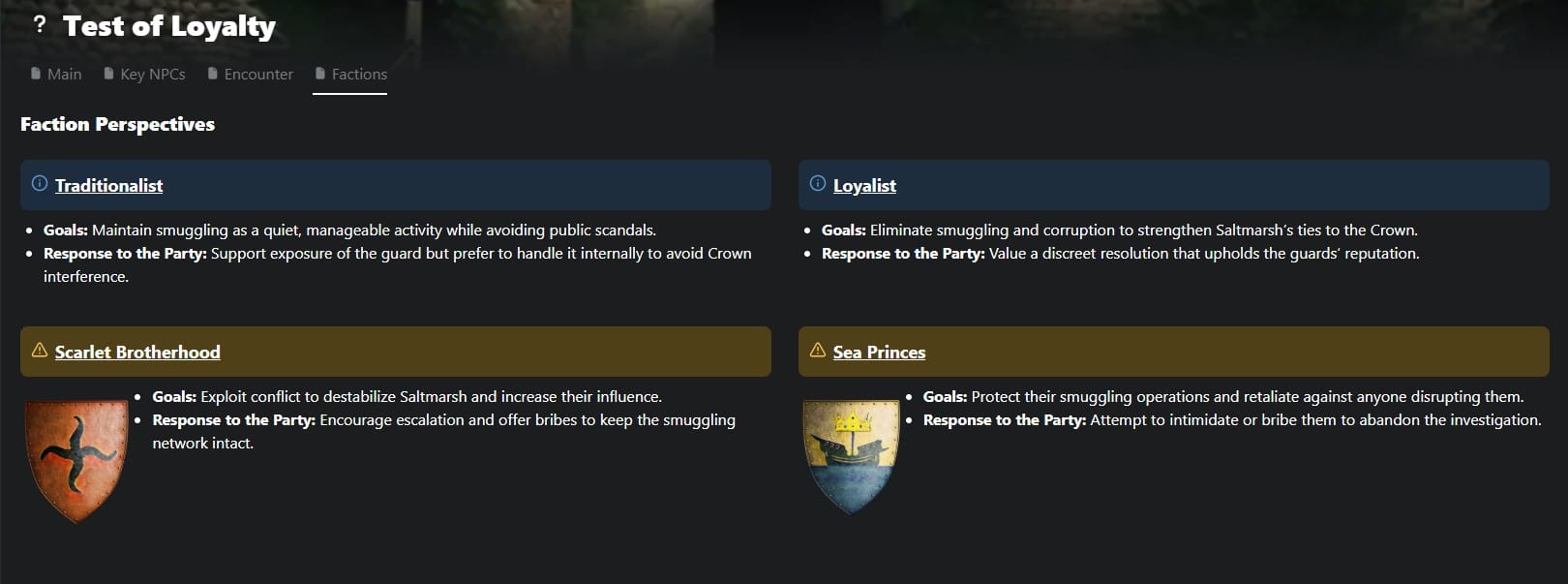
| DMG 2024 Approach | Medieval 5e Approach |
|---|---|
|
Uses three attitudes: Friendly, Indifferent, and Hostile. Determines rolls as Advantage / Normal / Disadvantage. |
Expands into five tiers — Ally → Friendly → Neutral → Unfriendly → Enemy Offering greater nuance while remaining streamlined. |
|
Transparent DCs and mechanical: Players always know whether they are liked or hated based on roll modifiers. |
DCs are secret: NPC reactions, tone, and body language reveal attitude through narrative cues rather than numbers. |
|
Relies on open mechanics: “You have advantage to persuade the guard.” |
Relies on description: “The guard’s stance softens; his suspicion fades as he considers your words.” |
|
Simple and fair: Ideal for new tables or quick resolution. |
Subtle and story-driven: Suited to campaigns emphasizing politics, factions, and reputation such as Ghosts of Saltmarsh. |
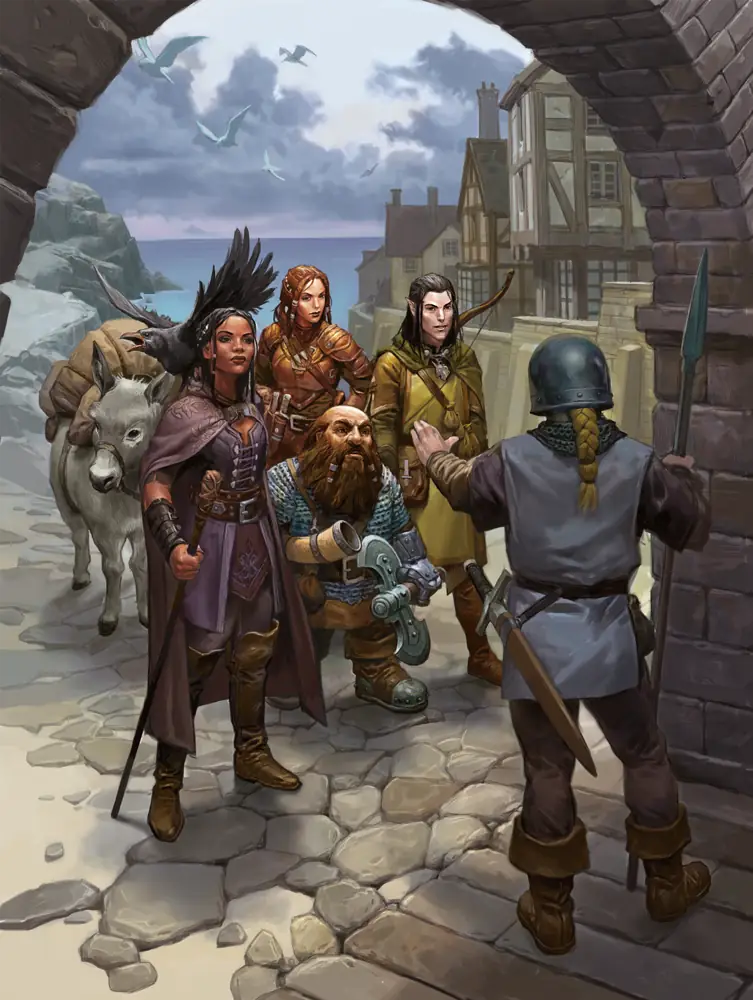

Member discussion: